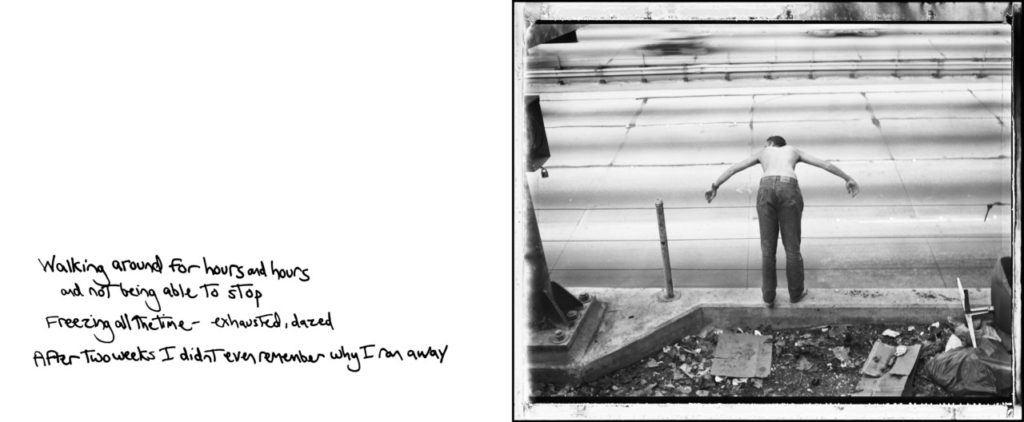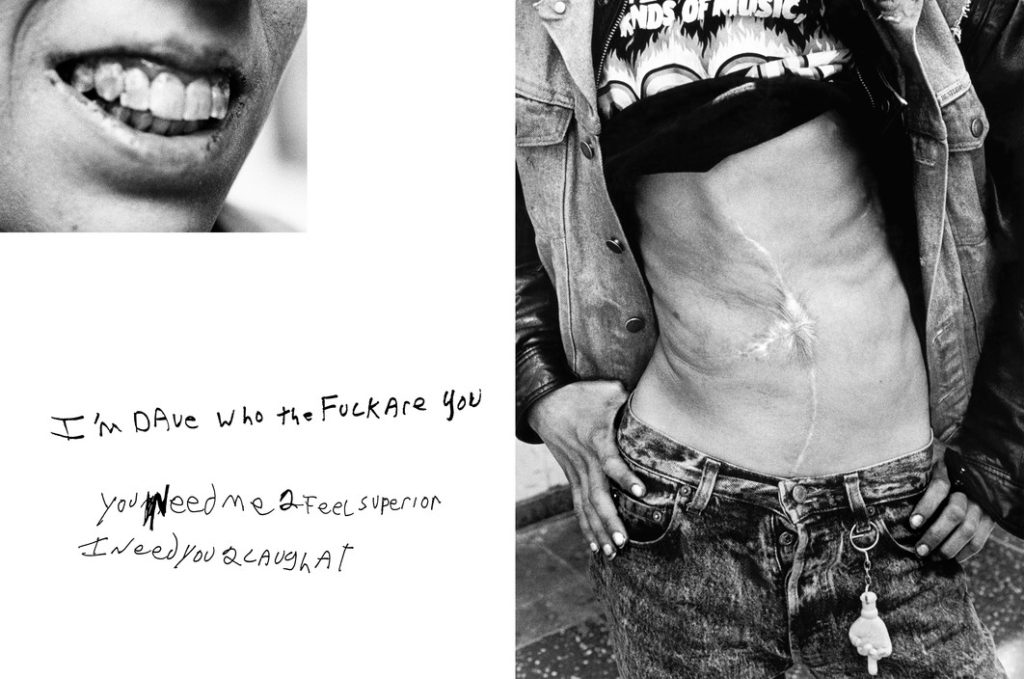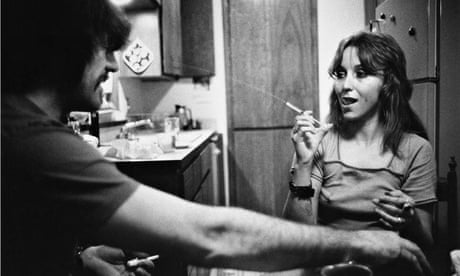For my personal investigation I intend to create a photo-book project around the theme of documenting the youth of today and our culture, which is rarely portrayed accurately in the media, this may also include certain subcultures that I could decide to delve into. I will try the best I can to capture and achieve a realistic portrait of each individual person. The question then arises, ‘What does a ‘real photo’ even look like: is it something you can hold? Is it something you can see on a screen and alter?’ (Bright, S. and Van Erp, H. 2019: 17.) I hope to answer this question throughout my efforts of trying to capture a ‘real’ portrait of an individual. How much can you really tell about a person through looking at a mere photograph of them?
Throughout my research I have looked at a few documentary photographers who I think have been close or have achieved an almost perfect, realistic representation of an individual. An example of this is Jim Goldberg, an accomplished photographer and creator of the renowned photo-book ‘Raised by Wolves’. Published in 1995, this was a decade long project for Goldberg, in which he documented a factual representation of the youth living on the streets of California and San Francisco; at the height of the AIDS epidemic and surrounded by drug abuse and violence.

A key aspect of ‘Raised By Wolves’ was that it did not only include straight up photographs of the individuals, but it also included drawings and writings by them. Many photos in the collection have been scrawled with their own mini biography, such as Dave: an important character in ‘RBW’, in a double page spread featuring him (below), the words ‘I’m Dave, who the fuck are you? You need me to feel superior. I need you to laugh at’ are featured in his own handwriting. This has definitely impacted the authenticity of the images and made a bigger impact. This has provided another layer in which Goldberg has allowed these individuals to tell their own story through his efforts.
“I had the idea of having people write their stories on the photographs and, although I didn’t really know what I was doing, that turned out to be something really integral to my practice for 40 years. I just saw something that I felt I needed to try and make sense of. And using text enabled me to do that. ” (Jim Goldberg, ‘Raised By Wolves’, Huck 52 – The Documentary Photography Special 3)

Key Image Analysis: Dave, nicknamed ‘Tweeky Dave’, appeared as one of the most charismatic and sympathetic characters in Raised by Wolves. His early childhood had been plagued by abuse from his parents, addiction and constant violence. At the heart of the book is his doomed ‘love story’ between two 16-year-old runaways. Tweeky Dave and Beth, known as Echo, share an appetite for heroin but not much else. He moons after her, proposing marriage and children, fueled by impossible, sweet bravado as he walks, half-starved, down Hollywood Boulevard with his bedroll. She recognizes him as worse than a bad risk and dumps him to run with other boys, who abuse her. She becomes pregnant, has her baby, then returns, broke, to her mother’s home. The photo above is in my opinion one of the most disturbing in the book, it depicts Dave, the 16 year old runaway’s malnourished body. His scar from where his father shot him in the gut at ten years old is very apparent, he almost shows it off to the camera in a model pose-esque manner. Dave is dirty from his years spent on the streets, his hands and nail permanently tarnished, as well as his teeth covered in plaque and falling apart, from years of drug abuse and lack of cleanliness or medical care. Technically the image in itself is split into two sections, one a main body shot showing his clothing, scars. The other, a white page with a note saying ‘I’m Dave who the fuck are you? You need me 2 feel superior I need you 2 laugh at.’ Like most of the images in the book, it is black and white against a white background, this allows more emphasis to the tone, texture, line, light, and the balance of the composition. Goldberg hasn’t prepared this image at all, which is obvious: natural-on the street lighting is used, the image has in no way been staged and was most likely taken in the moment.
When discussing documentary photography I think one must also mention the photography movement which was Realism/Straight Photography. This is a concept of photography in which the reliance is on the camera’s technical ability to produce an image in sharp detail and without manipulation. Straight Photography images ‘depict the scene or subject as the camera sees it.’ These approaches to photography continue to define contemporary photographs, while being the foundation for many related movements, such as Documentary, Street photography and Photojournalism. Straight photography is often described as a ‘snapshot in time’ or a moment frozen in time, as it is a process and time based approach. ‘It represents immediacy, the passing of time as in history, or the freezing of time as in a snapshot. As Henri Cartier-Bresson once stated “we work in unison with movement as though it were a presentiment on the way in which life itself unfolds. But inside movement there is one moment in which the elements in motion are in balance.” This notion of the “decisive moment” defined much of the Straight photography of the mid-20th century. ‘ (The Art Story- Straight Photography Movement). This movement relates completely to my study on Goldberg’s work. There is a sense of realness and immediacy within every photo in RBW. One in particular which I find to be the most genuine and ‘in the moment’ is the image of 14 year old girl, pregnant with triplets eating out of a box of cheerios in an empty kitchen. Alongside a drawing from a notebook of her father supposedly having sex with her. If the question we are asking is: are we capturing reality? Then I think that the answer is clearly yes, however every person will always react or interpret an image differently. ‘Photography merely depicts bodily functions: sex not love, violence not hate.’ (Eric Margolis: ‘The Matter with Kids Today’:98) A person’s thoughts, feelings and experiences will most likely always manipulate their view of a photograph. At the end of the day, the girl is still just a child caught in a world where she will have to grow up quickly and Goldberg has captured this in one telling image.


Another Photographer who was criticized for his controversial career was filmmaker and photographer Larry Clark. 18 year-old Clark began his career photographing the daily lives of his friends. Over the next several years, he revisited the project that ultimately culminated in the 1971 publication of the book Tulsa. This iconic and controversial book sparked the beginning of the world-renowned photographer / filmmaker’s creative journey. These photographs launched both Clark’s career and a new style of photography ‘marked by equal parts intimacy and objectivity, treating shocking images of sex, violence, and drug use as ordinary occurrences alongside pictures of friendly parties and moments of solitary contemplation.'(Phil-brook Museum of Art: Larry Clark, Tulsa).


Similar to Goldberg, Clark seemed over his career to have a growing obsession for documenting the lives of teenagers, both photographers documented the lives of the teenagers in very similar ways, through black and white straight photography and immersing themselves in their subjects. This is an element which I tried to re-create in my own photography, although it is of course different as I am one with the group already: I know all the subjects well and my photos were in a sense planned, as in most occasions, I went out specifically to take the photos. Clark and I also have this in common, as he (in the making of Tulsa) was among those he was photographing, they were his everyday friends and it was his everyday life back then. Below are some of my own images and responses to the various photographers I have looked at throughout my personal investigation.



To conclude, Jim Goldberg and Larry Clark both effectively capture the lives and routines of teenagers living on the streets the 70s,80s and 90s in the US. Through their documentary photography showing sex, drug use, pregnancies and the abundance of drug use and poverty surrounding their lives. Their method of straight photography clearly shows this without any manipulation to the stories or images included and brings into discussion challenging aspects of the morals and ethics of representation in this genre of photography. Both photographers have been able to tell “their truth”, whilst carefully avoiding elevating the subjects to the status of folk-hero. Its seems that navigating these tricky waters can change the outcome of any photographers work, so that we end up with different versions of the same truth.
Bibliography: New York Times, Magnum Photos https://www.theartstory.org/movement/straight-photography/ https://philbrook.org/larry-clarks-tulsa-comes-home/
